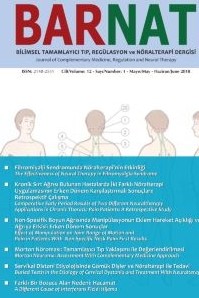BEL AĞRISI OLAN HASTALARDA TENS’İN AĞRI VE YAŞAM KALİTESİ ÜZERİNE ETKİNLİĞİ: ÖN ÇALIŞMA
Giriş: Bel ağrısı sık görülen, her yaştan insanı etkileyen ve dünya çapında hastalık yüküne katkıda bulunan bir durumdur. Sakatlığın
önemli nedenlerinden biridir. Transkutanöz elektriksel sinir stimülasyonu (TENS), bel ağrısının yönetiminde farmakolojik olmayan bir
tedavi yöntemi olarak yaygın şekilde kullanılmaktadır. Çalışmamızın amacı bel ağrısında TENS uygulamasının ağrı ve fonksiyonellik
üzerine etkisini değerlendirmektir.
Materyal-Metod: Poliklinikte bel ağrısı tanısı konmuş 21 hasta (7E, 14K) çalışmaya alındı. Hastalara haftada üç gün 20 dakika toplamda
15 seans tedavi uygulandı. Hastalar tedavi öncesinde ve tedavi sonrası beşinci haftada değerlendirildi. Ağrının şiddeti Vizüel Analog
Skala (VAS) ile fonksiyonel durum ve yaşam kalitesi Oswestry Bel Ağrısı Engellilik Anketi (OBA) ile değerlendirildi.
Bulgular: TENS uygulaması sonrası hastaların tedavi öncesi ve tedavi sonrası VAS ve OBA değerleri istatistiksel olarak anlamlı şekilde
azalmıştı (tüm p< 0.001) ve tedavi sırasında herhangi bir yan etkiye rastlanmadı.
Sonuç: TENS uygulamasının bel ağrısında ağrı ve fonksiyonellik üzerine etkili olduğunu ve tercih edilecek farmakolojik olmayan bir
tedavi yöntemi olabileceğini düşünmekteyiz.
Anahtar Kelimeler:
Bel ağrısı, Transkutanöz elektriksel sinir stimülasyonu, Vizüel Analog Skala.
THE EFFICACY OF TENS ON PAIN AND QUALITY OF LIFE IN PATIENTS WITH LOW BACK PAIN: A PRELIMINARY STUDY
Introduction: Low back pain is a common condition that affects people of all ages and contributes to the worldwide burden of
disease. It is one of the major causes of disability. Transcutaneous electrical nerve stimulation (TENS) is widely used as a non-pharmacological
treatment modality in the management of low back pain. The aim of our study is to evaluate the effect of TENS application
on pain and functionality in low back pain.
Materials and Method: 21 (7M, 14F) diagnosed with low back pain in the outpatient clinic were included in the study. A total of
15 sessions of 20 minutes of treatment were applied to the patients, three days a week. The patients were evaluated before the
treatment and at the fifth week after the treatment. The severity of pain was evaluated with the Visual Analogue Scale (VAS) and
functional status and quality of life were evaluated with the Oswestry Low Back Pain Disability Questionnaire (ODI).
Results: After TENS application, the pre- and post-treatment VAS and ODI values of the patients were statistically significantly decreased
(all p< 0.001) and no side effects were observed during the treatment.
Conclusion: We think that TENS application is effective on pain and functionality in low back pain and may be a preferred nonpharmacological
treatment method.
___
- Maher C, Underwood M, Buchbinder R. Non-specific low back pain. Lancet. 2017;389(10070):736-47.
- ISSN: 2148-2551
- Başlangıç: 2006
- Yayıncı: Bilimsel Nöralterapi ve Regülasyon Derneği
Sayıdaki Diğer Makaleler
EFFICACY OF NEURAL THERAPY IN THE TREATMENT OF NOTALGIA PARESTHETICA: REPORT OF TWO CASES
OBEZİTEYE İKİNCİL GONARTROZ VAKALARINDA AKUPUNKTUR UYGULAMA SONUÇLARI
BEL AĞRISI OLAN HASTALARDA TENS’İN AĞRI VE YAŞAM KALİTESİ ÜZERİNE ETKİNLİĞİ: ÖN ÇALIŞMA
Ezgi AYDIN, Fatma Gülçin URAL NAZLIKUL
Hüma BÖLÜK ŞENLİKCİ, Dilek DİZDAR
